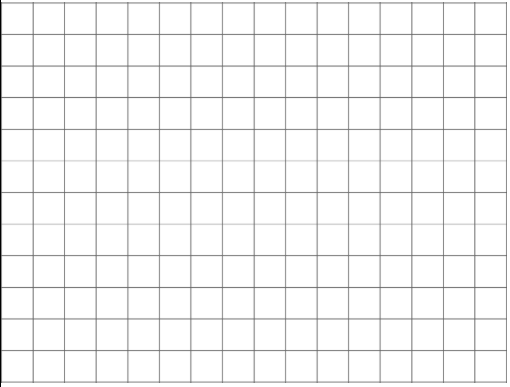28.1: Decimal Points in Products
- Page ID
- 40305
Lesson
Let's look at products that are decimals.
Exercise \(\PageIndex{1}\): Multiplying by 10
- In which equation is the value of \(x\) the largest?
\(x\cdot 10=810\qquad x\cdot 10=81\qquad x\cdot 10=8.1\qquad x\cdot 10=0.81\)
- How many times the size of \(0.81\) is \(810\)?
Exercise \(\PageIndex{2}\): Fractionally Speaking: Powers of Ten
Work with a partner. One person solves the problems labeled “Partner A” and the other person solves those labeled “Partner B.” Then compare your results.
- Find each product or quotient. Be prepared to explain your reasoning.
Partner A
- \(250\cdot\frac{1}{10}\)
- \(250\cdot\frac{1}{100}\)
- \(48\div 10\)
- \(48\div 100\)
Partner B
- \(250\div 10\)
- \(250\div 100\)
- \(48\cdot\frac{1}{10}\)
- \(48\cdot\frac{1}{100}\)
- Use your work in the previous problems to find \(720\cdot (0.1)\) and \(720\cdot (0.01)\). Explain your reasoning.
Pause here for a class discussion. - Find each product. Show your reasoning.
- \(36\cdot (0.1)\)
- \((24.5)\cdot (0.1)\)
- \((1.8)\cdot (0.1)\)
- \(54\cdot (0.01)\)
- \((9.2)\cdot (0.01)\)
- Jada says: “If you multiply a number by 0.001, the decimal point of the number moves three places to the left.” Do you agree with her? Explain your reasoning.
Exercise \(\PageIndex{3}\): Fractionally Speaking: Multiples of Powers of Ten
- Select all expressions that are equivalent to \((0.6)\cdot (0.5)\). Be prepared to explain your reasoning.
- \(6\cdot (0.1)\cdot 5\cdot (0.1)\)
- \(6\cdot (0.01)\cdot 5\cdot (0.1)\)
- \(6\cdot\frac{1}{10}\cdot 5\cdot\frac{1}{10}\)
- \(6\cdot\frac{1}{1,000}\cdot 5\cdot\frac{1}{100}\)
- \(6\cdot (0.001)\cdot 5\cdot (0.01)\)
- \(6\cdot 5\cdot\frac{1}{10}\cdot\frac{1}{10}\)
- \(\frac{6}{10}\cdot\frac{5}{10}\)
- Find the value of \((0.6)\cdot (0.5)\). Show your reasoning.
- Find the value of each product by writing and reasoning with an equivalent expression with fractions.
- \((0.3)\cdot (0.02)\)
- \((0.7)\cdot (0.05)\)
Are you ready for more?
Ancient Romans used the letter I for 1, V for 5, X for 10, L for 50, C for 100, D for 500, and M for 1,000. Write a problem involving merchants at an agora, an open-air market, that uses multiplication of numbers written with Roman numerals.
Summary
We can use fractions like \(\frac{1}{10}\) and \(\frac{1}{100}\) to reason about the location of the decimal point in a product of two decimals.
Let’s take \(24\cdot (0.1)\) as an example. There are several ways to find the product:
- We can interpret it as 24 groups of 1 tenth (or 24 tenths), which is 2.4.
- We can think of it as \(24\cdot\frac{1}{10}\), which is equal to \(\frac{24}{10}\) (and also equal to 2.4).
- Multiplying by \(\frac{1}{10}\) has the same result as dividing by 10, so we can also think of the product as \(24\div 0\), which is equal to 2.4.
Similarly, we can think of \((0.7)\cdot (0.09)\) as 7 tenths times 9 hundredths, and write:
\(\left(7\cdot\frac{1}{10}\right)\cdot\left( 9\cdot\frac{1}{100}\right)\)
We can rearrange whole numbers and fractions:
\(\left(7\cdot 9\right)\cdot\left(\frac{1}{10}\cdot\frac{1}{100}\right)\)
This tells us that \((0.7)\cdot (0.09)=0.063\).
\(63\cdot\frac{1}{1,000}=\frac{63}{1,000}\)
Here is another example: To find \((1.5)\cdot (0.43)\), we can think of 1.5 as 15 tenths and 0.43 as 43 hundredths. We can write the tenths and hundredths as fractions and rearrange the factors.
\(\left(15\cdot\frac{1}{10}\right)\cdot\left( 43\cdot\frac{1}{100}\right) =15\cdot 43\cdot\frac{1}{1,000}\)
Multiplying 15 and 43 gives us 645, and multiplying \(\frac{1}{10}\) and \(\frac{1}{100}\) gives us \(\frac{1}{1,000}\). So \((1.5)\cdot (0.43)\) is \(645\cdot\frac{1}{1,000}\), which is \(0.645\).
Practice
Exercise \(\PageIndex{4}\)
- Find the product of each number and \(\frac{1}{100}\)
\(122.1\qquad 11.8\qquad 1350.1\qquad 1.704\)
- What happens to the decimal point of the original number when you multiply it by \(\frac{1}{100}\)? Why do you think that is? Explain your reasoning.
Exercise \(\PageIndex{5}\)
Which expression has the same value as \((0.06)\cdot (0.154)\)? Select all that apply.
- \(6\cdot\frac{1}{100}\cdot 154\cdot\frac{1}{1,000}\)
- \(6\cdot 154\cdot\frac{1}{100,000}\)
- \(6\cdot (0.1)\cdot 154\cdot (0.01)\)
- \(6\cdot 154\cdot (0.00001)\)
- \(0.00924\)
Exercise \(\PageIndex{6}\)
Calculate the value of each expression by writing the decimal factors as fractions, then writing their product as a decimal. Show your reasoning.
- \((0.01)\cdot (0.02)\)
- \((0.3)\cdot (0.2)\)
- \((1.2)\cdot 5\)
- \((0.9)\cdot (1.1)\)
- \((1.5)\cdot 2\)
Exercise \(\PageIndex{7}\)
Write three numerical expressions that are equivalent to \((0.0004)\cdot (0.005)\).
Exercise \(\PageIndex{8}\)
Calculate each sum.
- \(33.1+1.95\)
- \(1.075+27.105\)
- \(0.401+9.28\)
(From Unit 5.2.2)
Exercise \(\PageIndex{9}\)
Calculate each difference. Show your reasoning.
- \(13.2-1.78\)
- \(23.11-0.376\)
- \(0.9-0.245\)
(From Unit 5.2.3)
Exercise \(\PageIndex{10}\)
On the grid, draw a quadrilateral that is not a rectangle that has an area of 18 square units. Show how you know the area is 18 square units.

(From Unit 1.1.3)

